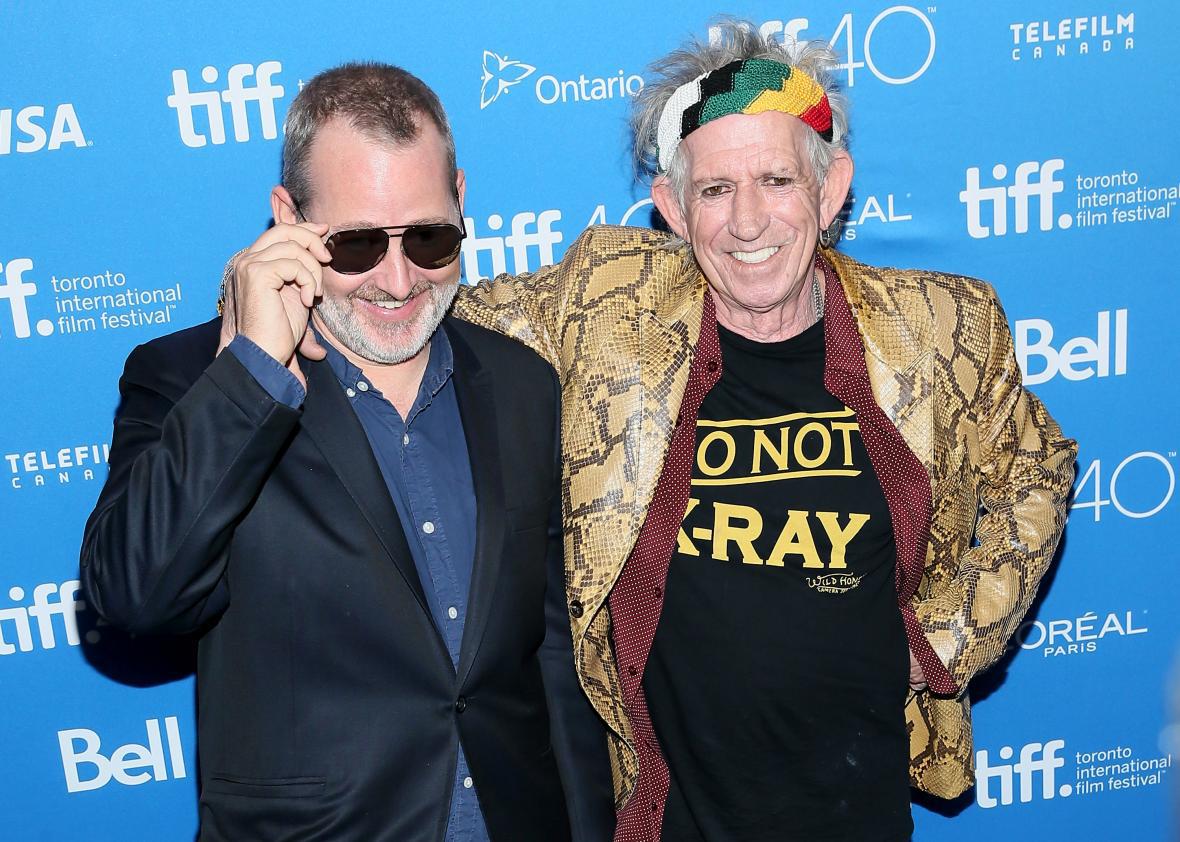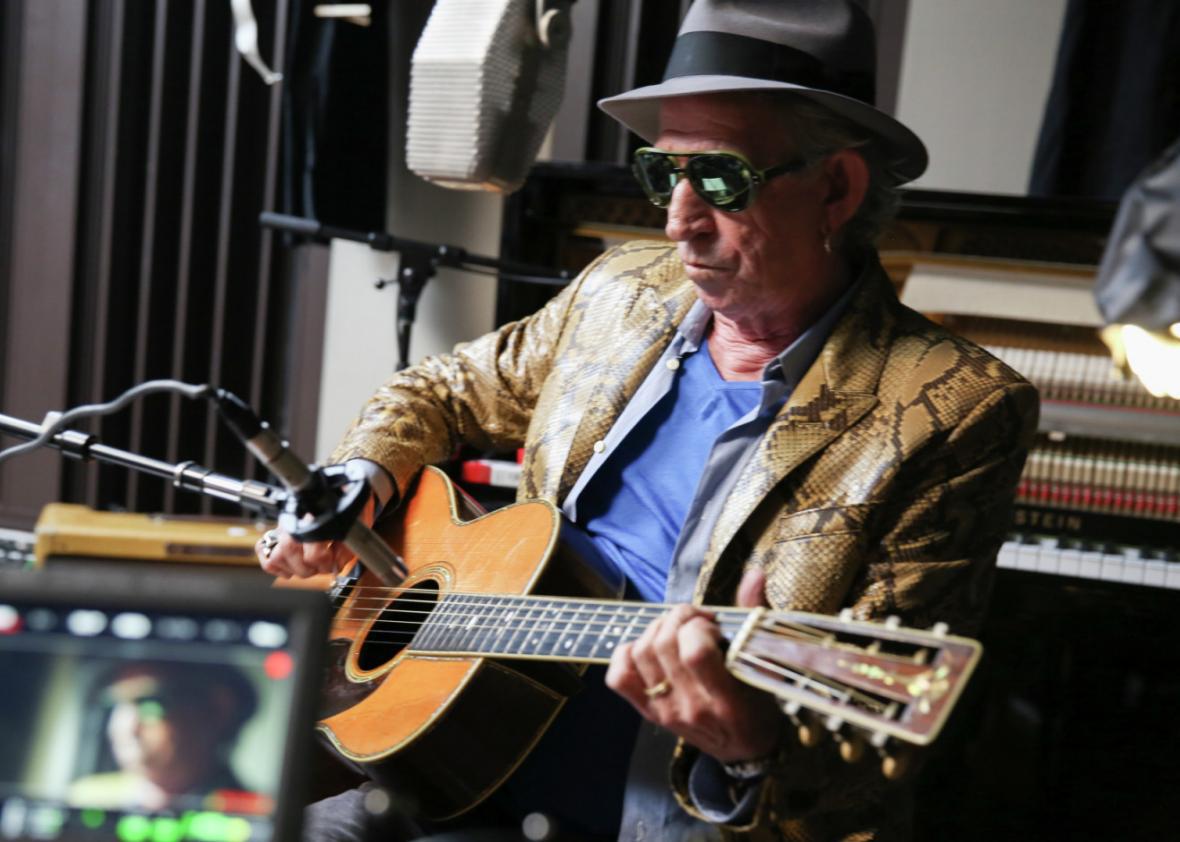“I always thought 30 was about it, beyond that it’d be horrible to be alive,” says Keith Richards at the beginning of Keith Richards: Under the Influence. “Until I got to be 31—then life ain’t so shabby, you know? I’ll hang in a while.”
For years, the running joke about the Rolling Stones rocker, who is now 71, has been that it’s a wonder that he’s still alive, considering his well documented wild days. The title of the new documentary from Morgan Neville (20 Feet From Stardom), out Friday on Netflix, is sort of a double entendre—while it may instantly conjure up thoughts of Richards’ notorious drug use, that’s not what the film is interested in at all. Instead, Under the Influence loosely traces Richards’ life through the artists who inspired him personally and as an artist, including Robert Johnson, Muddy Waters, and Chuck Berry. He also candidly discusses the history of such classic Stones songs like “Sympathy for the Devil” and “Street-Fighting Man,” while jamming in the studio and happily ruminating on life as a senior citizen. I spoke with Neville at the Toronto International Film Festival, where the film had its world premiere on Thursday.
How did this documentary come about?
By complete accident. He had an album coming out and they said well, we just want to film him, get something of him talking. And because it was Keith I jumped on it. I decided to bring a pile of albums with me and a turntable, and it’s the stuff you see in the film, on that first day, where we just talked about music for like three hours and it was amazing. And Jane, his manager, said, “Oh, Keith had a great time, we had a great time, that was great! Keep filming!”
Before we knew it we just had this feature-length documentary. And it was never supposed to be that, which is nice because to me the film is about—it’s not trying to tell a story. Its more just kind of like a portrait of Keith today. I wanted it to feel more like a hang with Keith. Do you ever listen to the Stones?
Oh yeah—I’m not a die-hard fan, but I like them.
I mean Keith’s been in a lot of documentaries, but never like this. And especially the Stones documentaries—when he comes together with the Stones, Mick is the front man. And Keithis very happy to just kind of lean against the wall with the sunglasses on. He’s got that persona that he kind of hides behind. But I feel like the book he wrote—Life, which came out 5 years ago—was kind of the beginning of this process. The film and the book are good companion pieces, because they both take this two-dimensional persona that he has and make it into something real. He wrote all those songs, he did all those things, and he’s not a cartoon—he’s a real person who listens to music and has a family and is funny and charming.

Photo by Jemal Countess/Getty Images
How long did you shoot for?
We did the entire film in four months. Which is really fast. It’s crazy. I have another film in the festival, this Yo-Yo Ma documentary, and that was like a four-year process. So I’m used to documentaries taking a long time. This one was just instinctual. It was like writing a rock song and going onto the next thing. No time to overthink it.
What surprised you the most about Keith while you were filming?
You tend to put your rock stars on pedestals—they seem like they’ve been there for time immemorial. But you realize that the rock stars have their own rock stars. They were fans and kids once too.
And you forget very easily that Keith Richards was half of one of the greatest songwriting teams in history. Being able to witness it and just sit there and watch him play and come up with things. As a fan, that stuff was just awesome.
Keith talks a lot about what it’s like to be his age—was this something you talked about beforehand or is it something that just arose as the film came together?
We had no agenda. This was really a chance to figure out what Keith wants to talk about too. Because I know he’s been interviewed a million times, I know he’s told some of the same stories a million times, everyone asks him about Mick, I get that. And I’ve asked him those questions before. But this time I felt like, let’s let the conversation to go wherever it goes.
Is there any moment that Keith revealed that didn’t make it into the film that you loved or appreciated?
I had a whole section about soul music and about Otis Redding. Otis covered “Satisfaction,” and to these guys, Otis’ version supersedes what they did–it’s the version they dreamed of. They always heard horns on the song, but could never do it.Hearing what that meant to have those artists start singing their songs—Aretha doing Stones songs, Ray Charles doing them, I mean all of those guys would cover the Stones. That dialogue back and forth was something that’s not in the film that meant a lot. Because we always hear about how the Stones covered those blues artists—but those blues artists covered them back.
You’ve done a lot of music docs—one on Brian Wilson, 20 Feet From Stardom. Who is the one musician you’d love to tackle and haven’t yet?
If I had a dream subject, I’d probably say David Bowie.
He’s writing a musical now, I think…
Yeah, I hear these whispers of things he’s doing, but he’s just one of those guys who’s never done a documentary, never cooperated with one. The stuff he was doing in the ’70s now seems like it’s just now found its time, it was so far ahead of its time. I could really sink my teeth into a David Bowie documentary.
